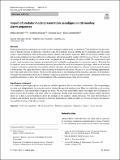Files in this item
Impact of predator model presentation paradigms on titi monkey alarm sequences
Item metadata
| dc.contributor.author | Berthet, Mélissa | |
| dc.contributor.author | Mesbahi, Geoffrey | |
| dc.contributor.author | Cäsar, Cristiane | |
| dc.contributor.author | Zuberbühler, Klaus | |
| dc.date.accessioned | 2022-10-26T13:30:01Z | |
| dc.date.available | 2022-10-26T13:30:01Z | |
| dc.date.issued | 2022-10-03 | |
| dc.identifier | 281880441 | |
| dc.identifier | 70988e72-969a-4fb1-94f3-e17a12b7a920 | |
| dc.identifier | 000862912200002 | |
| dc.identifier | 85139241938 | |
| dc.identifier.citation | Berthet , M , Mesbahi , G , Cäsar , C & Zuberbühler , K 2022 , ' Impact of predator model presentation paradigms on titi monkey alarm sequences ' , Behavioral Ecology and Sociobiology , vol. 76 , no. 11 , 143 . https://doi.org/10.1007/s00265-022-03250-1 | en |
| dc.identifier.issn | 0340-5443 | |
| dc.identifier.other | Jisc: 637966 | |
| dc.identifier.other | publisher-id: s00265-022-03250-1 | |
| dc.identifier.other | manuscript: 3250 | |
| dc.identifier.other | ORCID: /0000-0001-8378-088X/work/121753632 | |
| dc.identifier.uri | https://hdl.handle.net/10023/26254 | |
| dc.description | Open access funding provided by University of Zurich. This work received funding from the European Research Council under the European Union’s Seventh Framework Programme (FP7/2007–2013)/ERC grant agreement no. 283871 (PI: KZ), the Swiss National Science Foundation (NCCR Evolving Language, Swiss National Science Foundation Agreement #51NF40_180888) and the University of Neuchâtel. | en |
| dc.description.abstract | Predator presentation experiments are widely used to investigate animal alarm vocalizations. They usually involve presentations of predator models or playbacks of predator calls, but it remains unclear whether the two paradigms provide similar results, a major limitation when investigating animal syntactic and semantic capacities. Here, we investigate whether visual and acoustic predator cues elicit different vocal reactions in black-fronted titi monkeys (Callicebus nigrifrons). We exposed six groups of wild titi monkeys to visual models or playbacks of vocalizations of raptor or felid. We characterized each group’s vocal reactions using sequence parameters known to reliably encode predatory events in this species. We found that titi monkeys’ vocal reactions varied with the predator species but also with the experimental paradigm: while vocal reactions to raptor vocalizations and models were similar, felid vocalizations elicited heterogeneous, different reactions from that given to felid models. We argue that subjects are not familiar with felid vocalizations, because of a lack of learning opportunities due to the silent behaviour of felids. We discuss the implication of these findings for the semantic capacities of titi monkeys. We finally recommend that playbacks of predator vocalizations should not be used in isolation but in combination with visual model presentations, to allow fine-grained analyses of the communication system of prey species. Significance statement: It is common to present prey species with predator models or predator calls to study their vocal reactions. The two paradigms are often used independently, but it remains unclear whether they provide similar results. Here, we studied the vocal reactions of titi monkeys to calls and models of raptors and felids. We show that titi monkeys seem to recognize the vocalizations of raptors but not those of felids. The study of the vocal reactions emitted when titi monkeys cannot clearly identify the threat allows us to draw accurate hypotheses about the meaning of titi monkeys’ alarm utterances. We argue that playbacks of predator calls should be used in conjunction with model presentations, which can allow us to better investigate the information and the structure of the alarm systems. | |
| dc.format.extent | 14 | |
| dc.format.extent | 1043402 | |
| dc.language.iso | eng | |
| dc.relation.ispartof | Behavioral Ecology and Sociobiology | en |
| dc.subject | Callicebus nigrifrons | en |
| dc.subject | Model presentation | en |
| dc.subject | Playback experiment | en |
| dc.subject | Semantics | en |
| dc.subject | Syntax | en |
| dc.subject | Vocal reaction | en |
| dc.subject | BF Psychology | en |
| dc.subject | DAS | en |
| dc.subject.lcc | BF | en |
| dc.title | Impact of predator model presentation paradigms on titi monkey alarm sequences | en |
| dc.type | Journal article | en |
| dc.contributor.institution | University of St Andrews. Organic Semiconductor Centre | en |
| dc.contributor.institution | University of St Andrews. School of Psychology and Neuroscience | en |
| dc.contributor.institution | University of St Andrews. Institute of Behavioural and Neural Sciences | en |
| dc.contributor.institution | University of St Andrews. Centre for Social Learning & Cognitive Evolution | en |
| dc.identifier.doi | 10.1007/s00265-022-03250-1 | |
| dc.description.status | Peer reviewed | en |
This item appears in the following Collection(s)
Items in the St Andrews Research Repository are protected by copyright, with all rights reserved, unless otherwise indicated.

